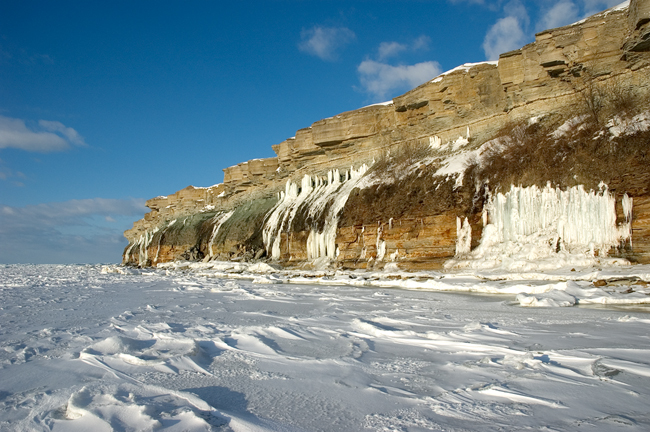What does the word klint mean?
In Swedish and Danish languages, klint means a coastal escarpment. In Swedish it also means a “steep-sloped mountain top” or “cornflower”. Driven by the eastward ambitions of the Danes and Swedes in the Viking Period, the word klint spread also into the languages of the countries of the Baltic east coast. A Swedish geologist and klint researcher A. Martinsson (1958) supposed that the word klint comes from the Swedish-Danish primal language word klev, which denoted an escarpment, be it on a seacoast or riverbank. From there the word was supposedly adopted through Scotland into the English language, where it has transformed into clint. The word exists also in Scottish but is not used in the meaning of an escarpment in English: the word clint(s) together with grike is used in English to characterize a karren landscape with widened joints (grikes) formed through the dissolution of jointed limestone surfaces, and smaller limestone blocks (clints) between them.
Both in German and Norwegian the word spells Glint. The word klint exists in the languages of most nations around the Baltic in the meaning of either an escarpment or a cliff: in German – Glint, Kliff, in Russian – глинт
(glint), in Lithuanian – klintis (means also limestone), in Latvian – klinšu or klints. In English-language professional literature, the term has been conveyed with the words cliff, coastal cliff, coastal escarpment, escarpment.
V. Paats (1995) notes that the words klint or glint have been in use in Estonian already since the 14th century in a variety of meanings: as a steep seacoast, cliff, hill, hill top, sandbank, fence and border. In a border dispute held in 1349 in the Tallinn Town Council, it is mentioned both as a fence (Glint dictum in vulgari) and a limestone wall (glintmure). Account books of Tallinn Town Council of 1481 and 1489 refer to a person called Jacob living at the foot of the klint (under deme klinte, Klynthe, klinde). In a South Estonian language grammar book by J. Gutslaff (1648) we find the word kiwwi-klindt (“rock klint”) and in Heinrich Göseken’s dictionary (1660) there occurs the word klint. A linguist August Wilhelm Hupel (1777, 1795), also known as a researcher of local history, uses the words klinde and klinte to denote a high steep cliff coast, i.e. klint, on the Baltic Sea. Johann Zēvers (Sehwers 1953) considers the word klint to be a Middle Lower German loan. In a study book “A Guide to Knowledge of Home- and Fatherland” by G. Blumberg (1871), the terms maltsa kallas and kõrge kallas (“high coast”) are used in this meaning. A famous linguist Ferdinand Johann Wiedemann (1805–1887) already used the word maltsakallas, while also suggesting the word kallastik and, somewhat later (in 1869), also pank (“cliff”) to denote the klint.
The word klint is not fully rooted in the Estonian language yet and since a rather suitable word pank (bank in English) is occupied by the name of a financial institution, it has been attempted to solve the problem in Estonian by several compound words – pankrannik (“cliff coast”), paekallas (“limestone bank”), paerannik (“limestone coast”). The first native Estonian geology professor Hendrik Bekker (1891–1925) suggested (1919) the word paesein (“limestone wall”) and a natural scientist Gustav Vilbaste (1885–1967) suggested järskrannik (“steep coast”) (1938). Pankrannik (“cliff coast”) is the most suitable of the suggested compound words, since what else could it mean but a coast of cliffs, but the common language has still preferred paekallas (“limestone bank”) for some reason, although the word is principally incorrect in this meaning (the sea has a coast, not bank).

North Estonian Klint at Pakri Peninsula.

